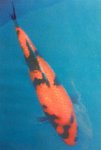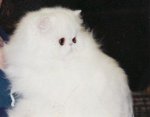Its rather complicated as there are 12 different classes of koi each with their own differing colours and markings.
Then to confuse things even more we have a catch all class making it 13 in all.
In the Gin Rin variety there are three differing types all to do with the dianond look on th koi's back however they must e strong in the tail area and the nos on this one says it has the potential for jumbo .
The way the diamonds appear eithr side of the dorsal is very uniform which is good, the markings are uniform on the koi with not too much sumi (black) and the orange is nice (not blotchy)I did a discription of all the Gin Rin markings for capewind I don think she'll mind if I copy it off from the message I sent :-
The Diamond gin rin is the most striking , yet least esteamed form of Gin Rin. It is also known as Hiroshima Gin Rin from its place of Origin in Southern Japan it can also cover a multitude of sins.
Kado Gin Rin Only the scales Leading edges are iridecent The amount of shiny Pigmentationmust be uniform across all scales.
The Gin Rin should extend over the dorsal surface although often it doesnt
Beto-GinIridecent pigment covers the entire scale surface not just the leading edge.
This type of Gin Rin is often found in borderline fish, idealy it should cover much of the body
Pearl Gin Rin also known as Tama Gin or Tsubo Gin.
This type of scale looks the best on younger koi, the centre of each scale carries a raised deposit of iridecence and gives the skin a 3D appearance.
Furkurin Scalation in the past decade leading breeder Matsunosuke has been deliberatly producing Go Sanke said to posses Fukurin scalation sceptics write it off as poor quality Kado-Gin so count this one out for now.
I hope this helps you understand the gin rin a little bit more
As you see I said three different types but in reality there is a fourth that nobody seems to rate which is the Furkurin scalation....
Ive added a link into all twelve classes and hope some images help to give you an idea of the above :-
http://www.macarthurwatergardens.com/koi-classifications.shtml
Also:-
http://www.pondtrademag.com/articles/ar-263/
Also :-
http://www.coloradokoi.com/kinginrin.htm
I hope this all helps you in understanding koi Great comments guys thank you all very much for them, lets hope it does well in this years show because I think it deserves it dont you ?
rgrds
Dave





